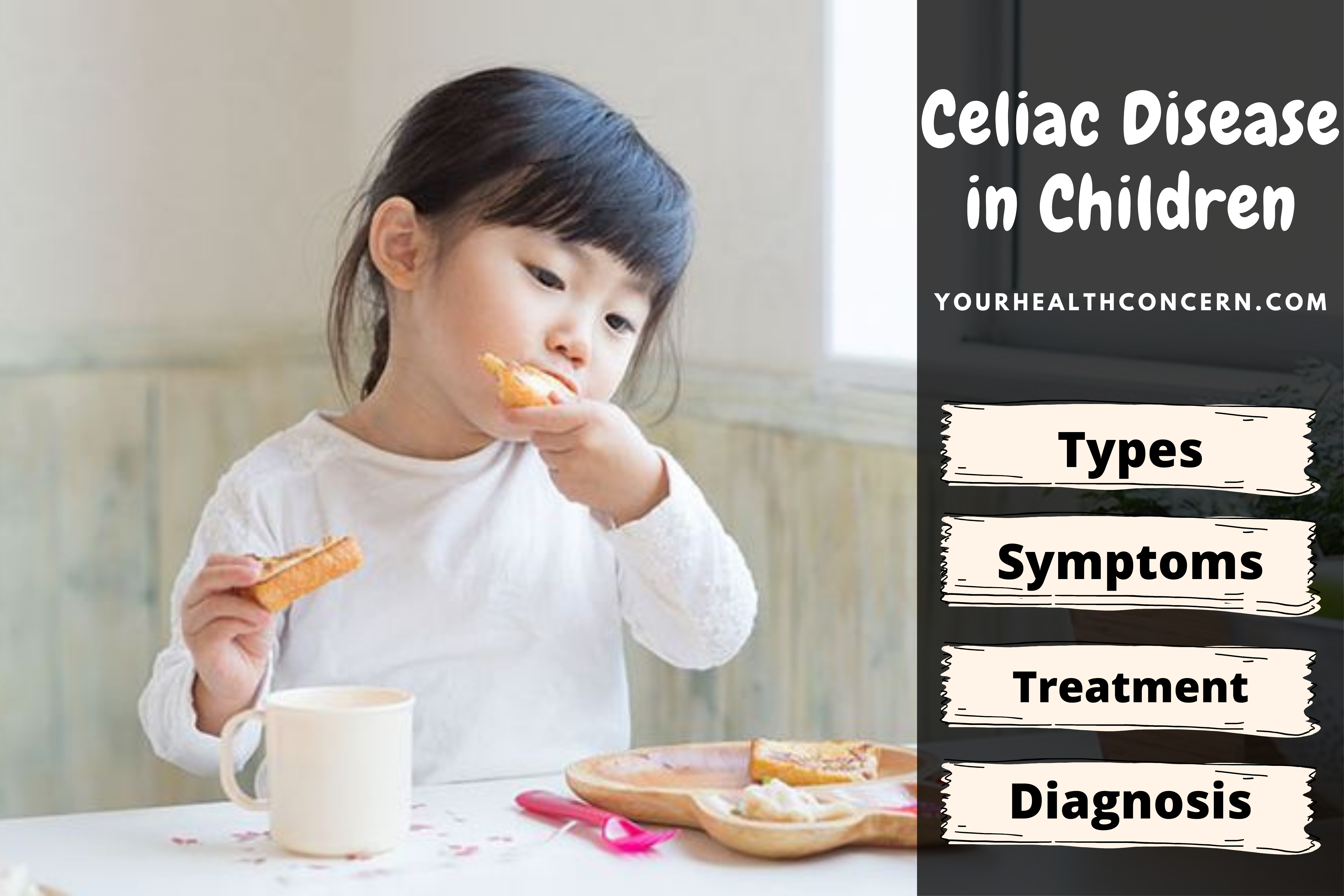Celiac Disease in Children: Types, Symptoms & Treatment
OverView
Celiac disease is a safe mediated crucial disease set off by confirmation of gluten in genetically weak individuals.
The regularity of celiac disease in everyone is 1% in the world.
Its power contrasts depending upon geological and ethnic assortments.
Celiac disease was once a young infection that could outgrow. We presently understand that celiac disease impacts everybody of all ages and races.
Moreover, sadly, celiac disease in children cannot outgrow. It is an enduring condition.
How is Celiac disease developed in kids?
Celiac disease could cultivate any time after wheat or other gluten-containing food sources are brought into the eating schedule, generally following 6-9 months mature enough.
Notwithstanding extended care and data about celiac disease, 95% of celiac patients stay unseen.
It is unknown why a couple of children become debilitated at every turn all through their day-to-day existence, and others become wiped out exclusively after extended lengths of receptiveness.
It is fundamental to test your youth at irrefutably the principal signs, then again expecting celiac disease runs in your friends and family. First-degree relatives have a 1 out of 10 chance of making celiac disease themselves.
Types
Celiac disease is of two sorts, each with its symptoms.
1. Classical celiac
People of this sort have signs of not having the choice to hold food supplements as they should.
- Free insides
- Steatorrhea, or pale, poisonous stools
- Weight decrease
- Powerlessness to fill in kids
2. Nonclassical celiac
People with this design may not give signs of issues holding supplements, yet they make different side impacts. Moreover, they habitually have various conditions and safe framework diseases.
- Swelling and torture
- Shortcoming
- Depletion
- Migraines
- Shuddering and deadness in hands or feet
- Inconvenience getting more slender
- Fruitlessness
- Trouble
- Strain
- Irksome skin (dermatitis herpetiformis)
Symptoms of Celiac Disease in Children
Symptoms of celiac disease vary with one individual and then onto the next and can begin at whatever stage throughout everyday life. Perceiving celiac disease in young people can be difficult, as dourness is perhaps the aftereffect for the kid. Moreover, only 20-30% of kids with celiac disease will have stomach incidental effects.
Common celiac disease’s secondary effects in kids include:
1. Reduced hunger
Children can be fussy eaters but can be made worse by celiac disease. Despite not wanting to eat explicit food sources, messes around with celiac disease experience pain (or all the more horrendous) due to their inability to eat gluten.
2. Failure to concede improvement or pubescence
Failure to prosper depicts kids far behind their partners in level and weight. Young people who disregard to thrive are regularly much more restricted and unobtrusive than various kids their age. As many as 10% of adolescents with no explanation for deferred advancement could have celiac disease. Adolescents disregard to prosper likely won’t experience the body changes with pubescence. Look further into powerlessness here.
3. Broadened stomach
Toddlers and little children with celiac disease could have a sticking “potbelly” or expanded midriff.
Other symptoms
Various other symptoms of celiac disease are:
- Whiteness
- Expanding and gas
- Progressing the runs or stoppage
- Hurt or stained tooth finish
- Fatigue
- Irksome skin rash (known as dermatitis herpetiformis)
- Sad weight gain
- Hurling
It is observed that practically 75% of children with celiac disease are overweight.
Severe Celiac Disease in Children
Several examples of celiac disease in immaturity are remarkable. Symptoms of outrageous cases include:
- Continuous shortcoming
- Outstandingly low circulatory strain
- Outrageous water adversity in stool, provoking electrolyte irritation
- A stomach block called intussusception
Causes behind the celiac disease in children
Specialists haven’t yet sorted out unequivocally that somebody makes celiac disease. We genuinely understand that young people with celiac disease gain one explicit quality from a parent that makes them frail.
Since numerous people have that quality never encourages celiac disease taking everything into account, various characteristics have an effect, too.
Several specialists recognize that celiac disease might be a blend of:
- having the gene(s) that make you frail
- receptiveness to gluten
- receptiveness to a toxic substance or a tainting (like rotavirus)
Diagnosis
If you figure your child could have celiac disease, you ought to have them attempted by a trained professional and keep them on a regular, gluten-containing diet all through the testing framework.
In light of everything, the celiac disease tests could be wrong if the youth is on a gluten diet.
The celiac disease testing process begins with a blood test. Investigate celiac disease testing here.
Accepting you are still up in the air to have celiac disease, Beyond Celiac will go with you continually.
Here are assets to guide you through an end:
The Getting Started Guide is a free and thorough booklet to get you going on the sans gluten diet.
Accepting your child tests negative for celiac disease, but you envision that child is genuinely encountering trouble with gluten, banter with your child’s pediatrician about non-celiac gluten responsiveness.
To investigate gluten mindfulness, experts first take out celiac disease and wheat responsiveness as likely results.
Then, an end diet is to sort out which food sources (if any) are causing secondary effects.
Treatment decisions for Celiac Disease
The primary treatment for celiac disease is extreme adherence to a sans gluten diet for eternity. It will allow your child’s absorption plots to repair and, in basically all cases, kill the secondary effects associated with celiac disease.
A selected dietician can meet with you and your family to inspect with you all that you truly need to know about a sans gluten diet, including:
- which food sources are safe
- which foods should not eat
- directions to scrutinize a food name
- the certified significance behind specific trimmings
- what to do when you’re unsure whether a food is safe
- guidelines to guarantee your child’s without gluten diet is invigoratingly changed
You may be stunned by the combination of food assortments that your child can eat, the very thing our enlisted dietitians will help you with. A strong without gluten diet consolidates a collection of new natural items, vegetables, rice, quinoa, millet, buckwheat, meats, and interminably milk things. There are bread, saltines, pasta, and desserts delivered utilizing the allowed grains.
Related: Celiac Disease Foods to Avoid: What foods not to eat?
Recovery
This movement is for each young person. A couple of youths feel far superior following two or three days on the without gluten diet, and for others, it takes a piece longer. There could be days when your youth doesn’t feel perfect. However, if accepting it perseveres, let your PCP know.
Final words
Celiac disease is a well-established bias to gluten, a protein found in wheat, grain, rye, and oats that have been with gluten from various things.
Celiac disease is a systematic disease. The quality of celiac disease has stretched out over the thirty years because of the information on subject matter experts and the use of altogether sensitive and unequivocal trademark tests for celiac disease.
Numerous still up in the air to have it when they’re between a half year and two years old, which is when most kids get their most memorable taste of gluten in a surprisingly long time.
The early finding is essential to hinder long stretch intricacies. The fruitful treatment is a well-established gluten-free diet.

